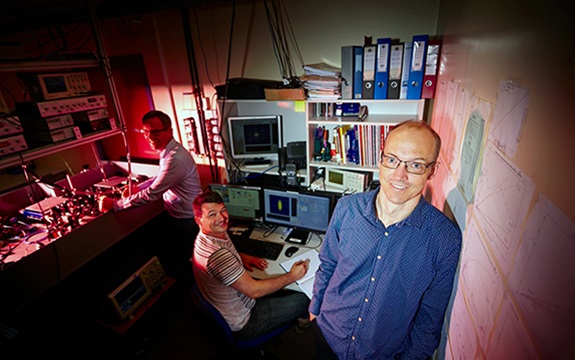4 July 2017
By gently prodding a swirling cloud of supercooled lithium atoms with a pair of lasers, and observing the atoms’ response, researchers at Swinburne have developed a new way to probe the properties of quantum materials.
Quantum materials — a family that includes superfluids, superconductors, exotic magnets, ultracold atoms and recently-discovered ‘topological insulators’ — display on a large scale some of the remarkable quantum effects usually associated with microscopic and subatomic particles.
But, while quantum mechanics explains the behaviour of microscopic particles, applying quantum theory to larger systems is far more challenging.
“While the potential of quantum materials, such as superconductors, is undeniable, we need to fully grasp the underlying quantum physics at play in these systems to establish their true capabilities,” says Chris Vale, an Associate Professor at the Centre for Quantum and Optical Science, who led the research. “That’s a big part of the motivation for what we do.”
Associate Professor Vale and his colleagues, including Sascha Hoinka and Paul Dyke, also at Swinburne, developed a new way to explore the behaviour of this family of materials. They detected when a ‘Fermi gas’ of lithium atoms, a simple quantum material, entered a quantum ‘superfluid’ state.
New system checks theories against experiment
Their system allows theories of superconductivity and related quantum effects to be precisely checked against experiment, to see whether the theories are accurate and how they could be refined.
The researchers’ advance was based on the fact that quantum materials’ special properties emerge when their constituent particles enter a synchronised state. The zero-resistance flow of electrons through superconductors, for example, emerges when electrons can team up to form ‘Cooper pairs’.
The team’s sophisticated experimental set-up allowed this co-ordinated quantum behaviour to be detected. By fine-tuning the interaction of their lasers with the Fermi gas, Associate Professor Vale and his colleagues were for the first time able to detect the elusive, low energy Goldstone mode, an excitation that only appears in systems that have entered a synchronised quantum state.
“Because our experiment provides a well-controlled environment and the appearance of the Goldstone mode is very clear, our measurements provide a benchmark that quantum theories can be tested against before they’re applied to more complex systems like superconductors,” Associate Professor Vale says.
“By developing methods to understand large systems that behave quantum mechanically, we’re building the knowledge base that will underpin future quantum-enabled technologies.”
The team's research has been published in the online journal Nature Physics.
This article featured in Swinburne’s 2017 ‘Research Impact’ magazine, produced in association with Nature Publishing Group.













